The post Paulina Rubio: Aprende por las malas appeared first on PETA.
Help PETA Close Live-Animal Markets
Live-animal markets (aka “wet markets”) sell live and dead animals and exist all around the globe, with more than 80 in New York City alone. In this video, Peter Li, an associate professor at the University of Houston–Downtown, states that at these markets, “The cages are stacked one over another. Animals at the bottom are often soaked with all kinds of liquid. Animal excrement, pus, blood.” Such conditions allow viruses to spread from one animal to another as well as to humans who come into contact with them. All such markets are potential breeding grounds for zoonotic diseases, such as COVID-19, SARS, and MERS.
 © Jo-Anne McArthur / We Animals
© Jo-Anne McArthur / We Animals
Just as we don’t want to be infected with the novel coronavirus or die from COVID-19, other animals don’t want to suffer or be slaughtered for food. Yet billions of chickens alone are killed for their flesh or exploited for their eggs each year, despite being sensitive, intelligent individuals who use more than 30 types of vocalizations to communicate about various threats approaching. And mother hens gently cluck to their chicks before they hatch.
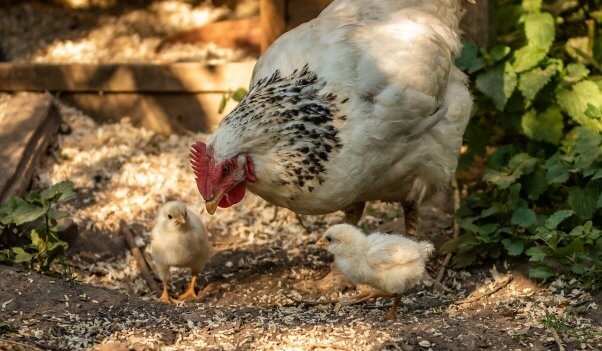
The World Health Organization (WHO) needs to call for a permanent end to live-animal markets. Make your voice heard by contacting the organization today.
- Leave a comment on its videos that mention COVID-19.
- On Instagram, tell WHO to call for an end to live-animal markets.
Comment on WHO Europe’s Instagram
- Leave a comment on its Facebook page.
- Use its contact form to send a personal message detailing why you want these markets permanently closed.
The post Help PETA Close Live-Animal Markets appeared first on PETA.
Meet the Winners of TeachKind’s 2020 Teacher Appreciation Contest
May was National Teacher Appreciation Month, and as always, TeachKind hosted its annual Teacher Appreciation Contest. Of course, the world of teaching (and at large) looks a lot different in 2020 than it has in years past, and teachers are working harder than ever to adapt to changing circumstances and brand-new challenges. That said, we’re honored to take this opportunity to thank the educators who are building a more compassionate world by teaching kindness and to shine a spotlight on the ways they’re going above and beyond for animals in their classrooms (both literal and virtual) every day.
We heard from dozens of teachers across the country who are dismantling speciesism and teaching students to have compassion for animals in all sorts of creative ways, and we’re endlessly impressed by the passion, bravery, and dedication that so many of you show in your quest to teach students about animal rights. With so many inspiring entries, narrowing them down surely wasn’t easy—but we know that these humane educators will inspire you as much as they did us.
Meet our wonderful Teacher Appreciation Contest winner and runners-up:
The Winner
Nina Otazo, Jane Long Academy, Houston, Texas

Nina is a high school English teacher and passionate vegan who is making a huge difference for animals and her students through her vegan advocacy and continual focus on dismantling speciesism in her classroom curriculum. She serves as the faculty sponsor for her school’s Vegan Cooking Club, in which students have learned about the benefits of vegan eating and whipped up delicious vegan dishes such as quesadillas, veggie sushi rolls, and pizzas and even worked with PETA to have Beyond Burgers and all the fixings donated as part of an animal-friendly cooking demo. Nina and her students also had the opportunity to cook a vegan feast for their local firefighters. Thanks to the club, many students on campus have had the opportunity to try delicious and healthy alternatives to animal-derived “products.” Nina also offers a variety of healthy vegan foods, including snacks, in her classroom and challenges her students to eat vegan outside the classroom, too.
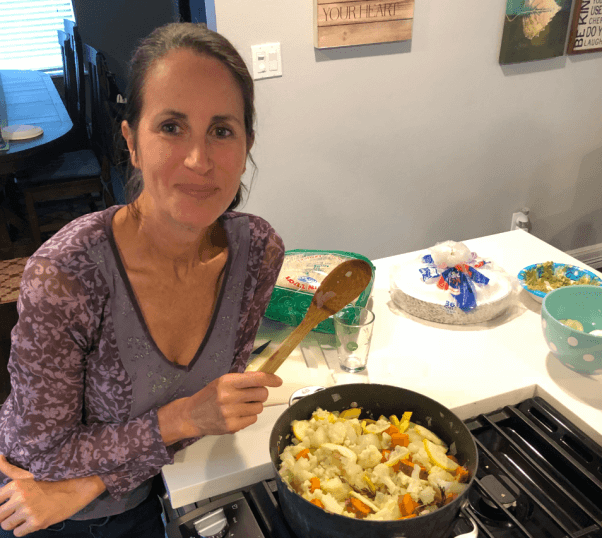
But Nina’s efforts for animals reach far beyond the realm of yummy vegan foods. She’s also working to dismantle speciesist beliefs in her students on a foundational level. She takes every opportunity to discuss speciesism with them and to facilitate open, honest, and interactive discussions about our society’s treatment of animals as part of her curriculum. For example, whenever she and her students encounter an example of speciesism in a text or film, she poses questions that help foster students’ compassion and critical thinking skills, reveal the intersectionality between animal rights and other social justice issues, and relate the plight of animals to students’ own experiences.
Nina incorporates TeachKind materials into her curriculum regularly and has worked with our staff on various humane education initiatives and projects, including by contributing to some of our educational materials on speciesism, hosting our staff members via Skype as guest classroom presenters to discuss vegan living with students, and participating in our animal-friendly idioms contest—for which she and her students won a custom-made poster! She has also hosted guest speakers to talk about mindful eating and has served vegan meals from local restaurants during each session. In the elective classes that she teaches, she screens vegan documentaries such as What the Health and The Game Changers to teach students about the ways that a vegan lifestyle benefits humans and other animals, and she also has her students write essays about the films.
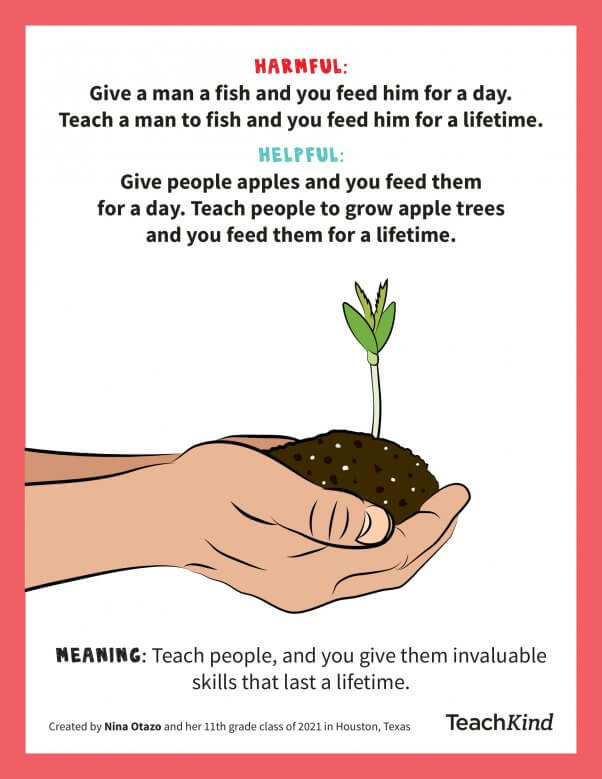
Poster inspired by Nina and her 11th grade students’ submission to TeachKind’s idioms contest.
Nina’s teaching methods are likely so effective because she treats her students as individuals with the capacity to make their own informed choices. She encourages other teachers to be sensitive about the way they approach students with information and to let conversations about animal rights happen organically—because no one wants to feel like they’re being manipulated by someone with an agenda. She sets positive examples by practicing “norm setting” (using unwritten rules in the classroom to normalize a behavior, such as talking about animal issues every day, safely removing bugs from the classroom instead of killing them, and always using animal-friendly and non-speciesist language) and using “signaling effects” (small messages in the classroom that signal information to students in a less direct way, such as putting animal rights–focused posters on the walls, offering free vegan snacks, or keeping photos of beloved animal companions visible).
Congratulations, Nina, and thanks for all of your hard work for animals!
The Runners-Up
Robyn Hicks, Zamboni Middle School, Paramount, California
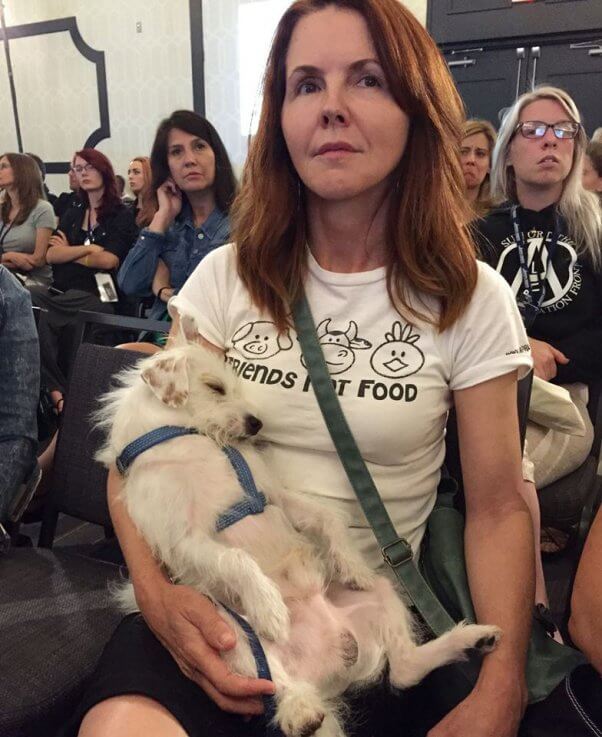
Robyn is a longtime animal rights activist and vegan, has been a public school teacher for more than 20 years, and currently teaches eighth grade U.S. history and government. She creatively and seamlessly weaves anti-speciesist messages into her curriculum, working lessons about animal rights into the framework of California’s History–Social Science Content Standards. When teaching about civil disobedience, for example, she cites civil actions taken by PETA and other animal rights organizations. When teaching about the Constitution, she has students write letters to their congressional representatives, and many choose to write about animal-related issues. She regularly hosts discussions with students about the intersectionality between animal rights and other social justice movements and covers animal rights topics across the board—from vegan food and clothing to animals used for entertainment and experiments. She shows documentaries such as Blackfish in class as well as footage depicting animal abuse in the circus from undercover investigations to help students understand the cruelty inherent in using animals for entertainment. She also takes students on field trips to animal sanctuaries such as The Gentle Barn and others, and she’s open about her vegan lifestyle, having become a resource for students who are interested in vegan eating.

In addition to her work in the classroom, Robyn is also the faculty adviser to her school’s animal rights club, P.A.W.Z., which she’s been running for the past six years. The group has written letters to government leaders about ending the use of animals in entertainment, held blanket drives for local animal shelters, and even taken action for injured animals they came across at school.
Thanks for inspiring students to choose kindness, Robyn!
Laura Goldberg, Thomas Jefferson Middle School, Fair Lawn, New Jersey
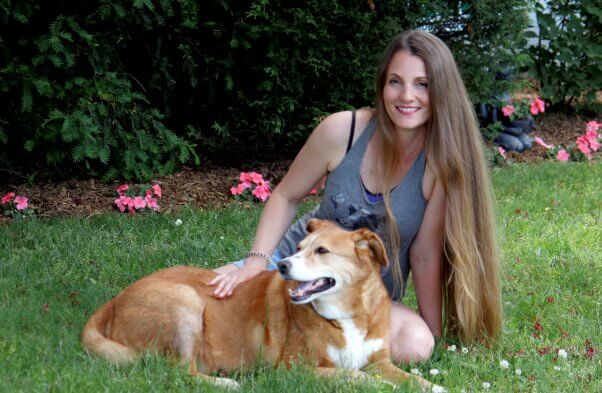
Laura has been a sixth grade science teacher for 15 years and is a passionate vegan. She stopped eating animals at age 10 and went vegan at age 18! She’s open about her vegan lifestyle and has offered countless students advice on animal-friendly eating and taught them and their families why it’s important to adopt animals from shelters rather than buying them from pet stores or breeders. She regularly incorporates TeachKind materials into her curriculum, using resources such as the PETA Kids comic book series as well as various videos, articles, and lessons from the TeachKind website. She has also successfully campaigned to end cruel chick-hatching practices in her school district.
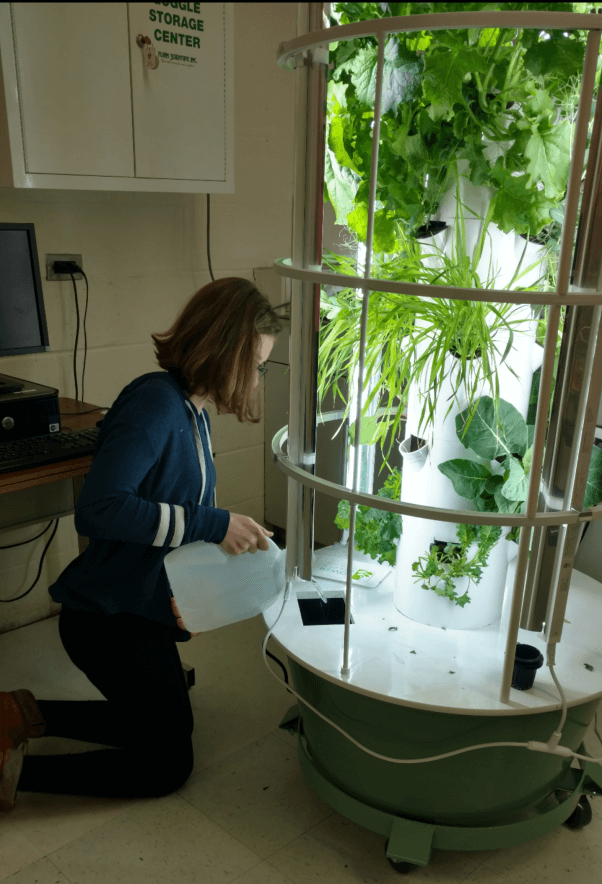
The garden tower in Laura’s classroom where she and her students grow vegetables.
Additionally, Laura runs her school’s animal rights club, in which students discuss and debate animal issues across the board, hold drives to collect supplies for local animal shelters, and host bake sales to raise money to sponsor animals from local animal sanctuaries, including Catskill Animal Sanctuary and Woodstock Farm Sanctuary. Her students also have a garden tower in the classroom where they grow kale and spinach, which is then served in the school’s cafeteria to encourage other students to eat more plant-based foods.
Thanks for your dedicated and inspiring work, Laura!
*****
Congratulations to these creative and compassionate educators! Are you ready to up your game for next year’s contest and put yourself in the running? We’ve got your back: Sign up for TeachKind’s Lesson of the Week for yearlong inspiration on incorporating kindness to animals in your classroom.
By submitting this form, you are agreeing to our collection, storage, use, and disclosure of your personal info in accordance with our privacy policy as well as to receiving e-mails from us.
The post Meet the Winners of TeachKind’s 2020 Teacher Appreciation Contest appeared first on PETA.
If These ‘Nemeses’ Can Collab on Seaside Sanctuary, What’s SeaWorld’s Holdup?
The Dolphin Marine Conservation Park (DMCP)—a marine park in Australia—is one of the latest facilities to embrace the idea of a seaside sanctuary and make SeaWorld look stubbornly foolish at the same time.

DMCP and two animal rights groups are setting aside their differences and joining forces for the benefit of Zippy (32), Bella (15), and Jet (11). These three bottlenose dolphins are currently housed at the Australian marine park, which has seen some harsh effects of COVID-19-related closures.
“They were our nemeses in the past,” Terry Goodall, the managing director of the marine park, reportedly said of Action for Dolphins and World Animal Protection, the two groups working with the park on proposing the seaside sanctuary, which would be a sectioned-off area of the Coffs Harbour International Marina in New South Wales, Australia. “Now we are holding hands and walking down the road together, trying to solve the problem. It’s just a complete and utter turnaround. We don’t agree on everything, but we agree on the wellbeing of the dolphins.”
Animal rights activists and dolphin zoo set aside enmity to collaborate on sea sanctuary https://t.co/Hwe61FbAAq
— Guardian Environment (@guardianeco) June 14, 2020
Jordan Sosnowski, advocacy director of Action for Dolphins, agreed that the alliance is a “very unique collaboration.” And for a group dedicated to helping dolphins, it’s appears to be a welcomed partnership. “A sea sanctuary … will allow the animals to live in the ocean and have a lot more autonomy, whilst still ensuring they are looked after and fed by caregivers,” Sosnowski pointed out. (The animals were born in captivity and therefore can’t simply be released into the open ocean.) Her group is the same one that sued the Japanese government over the legality of the Taiji slaughter, during which a reported 740 dolphins were either taken captive or killed.
In their Coffs Harbour sea sanctuary, Zippy, Bella, and Jet would no longer be forced to perform meaningless tricks in cramped tanks and instead would get to live in the ocean—swimming, diving, and doing other things essential to dolphins.
In the U.S., Baltimore’s National Aquarium is building a seaside sanctuary for the dolphins in its care …
Breaking: National Aquarium Announces that it will send captive dolphins to seaside sanctuary! https://t.co/pxDG4XcoKy
— PETA (@peta) June 14, 2016
… two whales have been moved from a marine park in China to a seaside sanctuary in Iceland …
The world's first beluga-whale sanctuary is opening next year in #Iceland!
#SeaWorld, you need to get on board with this. https://t.co/KCLyTGcBdQ
— PETA (@peta) July 16, 2018
… and The Whale Sanctuary Project recently announced plans for a seaside sanctuary for rescued orcas and belugas in Nova Scotia, Canada.
The Whale Sanctuary Project is planning to build a seaside sanctuary in Nova Scotia where rescued orcas and beluga whales will finally be able to swim in the ocean.#SeaWorld, release the animals NOW! https://t.co/ES0ipaLQaY
— PETA (@peta) February 28, 2020
Meanwhile, SeaWorld seems intent on resisting doing what’s right for animals, which is why we’re keeping the pressure on. We’ve been urging it to move the long-suffering captive marine mammals to seaside sanctuaries for years, even offering the abusement park a quarter of a million dollars to help build one. More recently, we’ve added a demand that SeaWorld stop breeding whales and all dolphins, just as it was compelled to stop breeding orcas in 2016 after facing mounting criticism.
Tell SeaWorld to Get With the Seaside Sanctuary Program, Too
PETA and our supporters have campaigned hard against SeaWorld for years, and we’ve scored victories for whales, dolphins, and other animals along the way. But we need your help to persuade the marine park company to stop breeding whales and all dolphins and to set in place a firm and rapid plan to release all the animals into seaside sanctuaries, where they’ll have a semblance of the natural life that they’ve been denied for so long. Click on the button below if you’re with us.
Do You Love Whales and Dolphins? Click Here!
The post If These ‘Nemeses’ Can Collab on Seaside Sanctuary, What’s SeaWorld’s Holdup? appeared first on PETA.
WODA European Natural Skin Care
The post WODA European Natural Skin Care appeared first on PETA.
